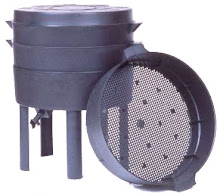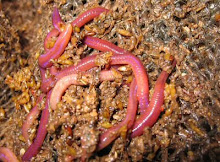Wednesday, April 28, 2010
New Digs for the Worm Bin!
For the past year and a half, my classroom worm bin has languished on the Pauahi Balcony, banished to an outdoor, isolated locale, thus defeating its original purpose to help educate students in sustainable practices. So, after harvesting the latest batch of vermicast two weeks ago, I moved the Can-O-Worms to a much better locale: it's now ensconced in a shady corner of the lovely Hogwarts Garden, where it'll be better appreciated. Alas, during the migration, quite a few worms liquified, on account of the wayward sun hitting the plastic bin that served as their temporary abode, but I have hopes that the population will regenerate soon.
Wednesday, January 20, 2010
January 19, 2010: Third Harvest and first of the New Year!
Harvested the third batch of vermicast: a portion of it is being donated to the gorgeous Hogwarts Garden, and another to the Merry Monkeys' garden at Manoa Valley Church Preschool, where they're growing lima beans and sunflowers.
My preschooler's two sunflower seeds, whose potting soil was enriched with vermicast, have sprouted! Hopefully, they'll survive the onslaught of slugs. We also used the rest of our vermicast to fertilize our backyard pakalana, kaffir lime, and banana trees; three of the latter are fruiting.
And finally: sighted at Whole Foods Market, Kahala, on Monday, 1/18/10: 1 pound of worm castings, selling for an exorbitant $20. "Black gold", indeed! Maybe I'm missing my calling...
My preschooler's two sunflower seeds, whose potting soil was enriched with vermicast, have sprouted! Hopefully, they'll survive the onslaught of slugs. We also used the rest of our vermicast to fertilize our backyard pakalana, kaffir lime, and banana trees; three of the latter are fruiting.
And finally: sighted at Whole Foods Market, Kahala, on Monday, 1/18/10: 1 pound of worm castings, selling for an exorbitant $20. "Black gold", indeed! Maybe I'm missing my calling...
Wednesday, October 21, 2009
Second Harvest Update
Vermicast-enriched pakalana. 
An update on how the second harvest is being used:
E., my friend and Hogwarts Garden overseer, used her vermicast to fertilize a bed of winter squash; said squash will be used in soup a few weeks from now. Can't wait to see the happy results. And L. will be using hers to feed her roses. M. and I have spread our bounty throughout our backyard garden: the pakalana plants, in particular, seem to be thriving, and our banana trees are issuing fruit. A few tomato plants have also unexpectedly sprung from the vermicast; suspect they're the scions of some overripe grape tomatoes one of my freshmen had fed to the worms over a year ago. Amazing to think that the seeds still remain viable after so long and after worm processing. But in our case, the renegade tomatoes are a welcome addition, making for a merrier garden, so we've let them be, in the hope of reaping future rewards.

An update on how the second harvest is being used:
E., my friend and Hogwarts Garden overseer, used her vermicast to fertilize a bed of winter squash; said squash will be used in soup a few weeks from now. Can't wait to see the happy results. And L. will be using hers to feed her roses. M. and I have spread our bounty throughout our backyard garden: the pakalana plants, in particular, seem to be thriving, and our banana trees are issuing fruit. A few tomato plants have also unexpectedly sprung from the vermicast; suspect they're the scions of some overripe grape tomatoes one of my freshmen had fed to the worms over a year ago. Amazing to think that the seeds still remain viable after so long and after worm processing. But in our case, the renegade tomatoes are a welcome addition, making for a merrier garden, so we've let them be, in the hope of reaping future rewards.
Monday, October 5, 2009
Vermicast: Second Harvest
The finished product, ready for use.
Harvested the second batch of vermicast this afternoon: moist, dark, and rich. This time, for whatever reason, there thankfully were not as many worms present in the tray as the last time--a good thing--though I left the lid uncovered and exposed to sunlight for a few hours, allowing any worms still lingering in the tray to wend their way downwards to what will be the working trays.
The harvest will be split amongst some gardener friends in the English Department, as well as donated to the Academy Garden growing behind Griffiths, a sustainability project spearheaded by my friend, E. I'm quite excited at the prospect of helping fertilize the lush basil, sunflowers, and taro that are currently growing there.

Harvested the second batch of vermicast this afternoon: moist, dark, and rich. This time, for whatever reason, there thankfully were not as many worms present in the tray as the last time--a good thing--though I left the lid uncovered and exposed to sunlight for a few hours, allowing any worms still lingering in the tray to wend their way downwards to what will be the working trays.
The harvest will be split amongst some gardener friends in the English Department, as well as donated to the Academy Garden growing behind Griffiths, a sustainability project spearheaded by my friend, E. I'm quite excited at the prospect of helping fertilize the lush basil, sunflowers, and taro that are currently growing there.
Tuesday, March 31, 2009
At long last: vermicast!
Harvested my first batch of vermicast yesterday afternoon. After spreading layers of newspapers to catch any moisture, I removed the heavy tiers one by one, laying them on the ground. Surprisingly, the contents of the second working tray almost looked ready to harvest as well: fine, dark, and moist, almost like a chocolate cake.
More worms were cruising the bottom tray than I anticipated, though the vermicast itself was perfectly decomposed, black as espresso grounds, save for tiny flecks of brown organic eggshells I'd added a year ago to the bin, and near-odorless, save for the faintest wisp of rainforest scent. Fortunately, though the weather was sunny, there was no light directly shining on the composter, so I placed the finished tray on the top of the bin, and left it uncovered, trusting that the worms, true to form, would skedaddle into the subterranean depths to avoid the sunlight. Sure enough, in an hour or so, I was able to scoop the finished vermicast into a sturdy plastic bin with handles, donated to the cause by my friend, S, without much incident--though I did find two stowaways this morning in the finished vermicast, who're currently residing in the scrap jar in my office, awaiting return to the composter.
More worms were cruising the bottom tray than I anticipated, though the vermicast itself was perfectly decomposed, black as espresso grounds, save for tiny flecks of brown organic eggshells I'd added a year ago to the bin, and near-odorless, save for the faintest wisp of rainforest scent. Fortunately, though the weather was sunny, there was no light directly shining on the composter, so I placed the finished tray on the top of the bin, and left it uncovered, trusting that the worms, true to form, would skedaddle into the subterranean depths to avoid the sunlight. Sure enough, in an hour or so, I was able to scoop the finished vermicast into a sturdy plastic bin with handles, donated to the cause by my friend, S, without much incident--though I did find two stowaways this morning in the finished vermicast, who're currently residing in the scrap jar in my office, awaiting return to the composter.
Friday, March 6, 2009
Coming Into the Home Stretch
Since it's been nearly eight months since my last post, I thought I'd give an update on the status of our bin. In September, we moved it out to the lanai of the building to avoid any unfortunate leachate leakage. At first, sun exposure was evaporating all the leachate--not necessarily a bad thing, as it makes for much easier maintenance if one doesn't have to drain out the moisture as often--but lately, I've had to drain quite a bit of liquid on a weekly basis, due to the generally cool and inclement weather of the past few months. Yesterday, I provided several containers worth to my fellow teacher, E., who has started up an Academy garden in conjunction with her "Nature" English elective. As of yet, the garden still lies fallow, as volunteers turned over the soil and mulched it just a few weeks ago; actual planting will not begin until May. The leachate will be used to supplement that garden as well as the kindergarten garden, so while we're still awaiting "black gold", our bin is still providing something useful to the larger school community.
The worms are thriving: I've watched several generations hatch from eggs, and when the protective layers of damp newspaper are moved in order to add food and circulate the organic matter, one sees a number of them squiggling into the subterranean depths, no doubt perturbed at the interruption of their slow, yet steady glutting. Unfortunately, the outdoor locale has also attracted less desirable life, namely outdoor cockroaches and ants, though I suppose I shouldn't be disparaging of the latter: after all, they too are decomposers and therefore, are serving a valuable function, even if they are loathsome...
I'm thinking about holding a (vermi)cast party and getting interested volunteers from the Hogwarts Community to help harvest the goods. Regardless of whether the party logistics come to fruition, however, I'm relishing the prospect of symbolically gifting the first vermicast so it fertilizes many gardens: those at the one at the Center for Public Service, the homes of faculty and staff, and our school.
The worms are thriving: I've watched several generations hatch from eggs, and when the protective layers of damp newspaper are moved in order to add food and circulate the organic matter, one sees a number of them squiggling into the subterranean depths, no doubt perturbed at the interruption of their slow, yet steady glutting. Unfortunately, the outdoor locale has also attracted less desirable life, namely outdoor cockroaches and ants, though I suppose I shouldn't be disparaging of the latter: after all, they too are decomposers and therefore, are serving a valuable function, even if they are loathsome...
I'm thinking about holding a (vermi)cast party and getting interested volunteers from the Hogwarts Community to help harvest the goods. Regardless of whether the party logistics come to fruition, however, I'm relishing the prospect of symbolically gifting the first vermicast so it fertilizes many gardens: those at the one at the Center for Public Service, the homes of faculty and staff, and our school.
Monday, July 21, 2008
The Third Tray is On!
The third, and final, tray was added to our Can-O-Worms on July 27, 2008. This layer requires no worm bedding, as the worms reside in the lower layers, and show up in the topmost tray only at mealtimes. In approximately 3 months or so, we should have our first vermicast harvest. Stay tuned.
Subscribe to:
Posts (Atom)

